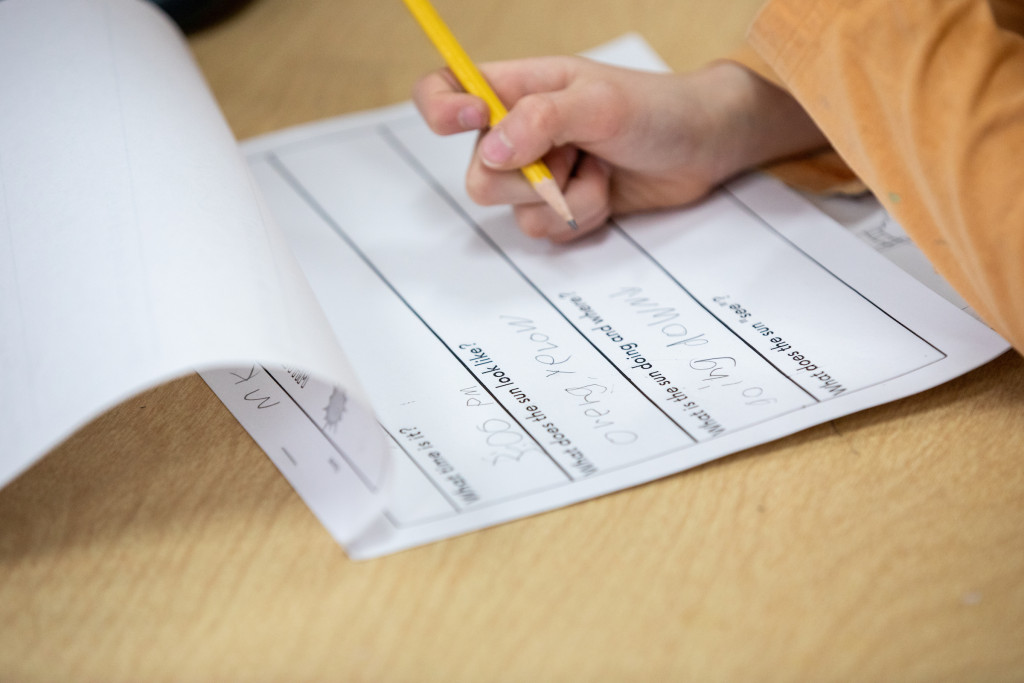Women shouldered most of kids’ in-home schooling needs during early pandemic

A new study found that women spent more time than men helping with in-home schooling during the early pandemic. In low-income households, the task took an even greater amount of women’s days. Sarah Maughan
Women took on more education-related childcare responsibilities than men during the first several months of the COVID-19 pandemic, and this disparity was even sharper for some lower-income women, according to a new University of Wisconsin–Madison study.
The study, published in the journal Sociology, found that daily time spent helping children with education-related activities, such as virtual schooling, homework and school projects, decreased for men in 2020 compared to previous years. For women, that daily time commitment more than doubled. For low-income women living in areas with widespread childcare facility closures during the pandemic, the increase in time was even steeper.
The study used 2020 data from the U.S. Database of Child Care Closures, a public database created by researchers at Columbia University, along with several years of daily time use data from the U.S. Bureau of Labor Statistics’ American Time Use Survey.

Ran Liu led the study and says the findings show a need for stronger support for women from care partners, childcare centers, schools and community organizations during similar public crises in the future. Sarah Maughan
Ran Liu, an assistant professor in the UW–Madison School of Education’s Department of Educational Policy Studies, says the findings show a need for stronger support for women from care partners, childcare centers, schools and community organizations during similar public crises in the future.
“Our analyses provide further evidence that the additional burden of child home education during the pandemic was almost entirely shouldered by women,” Liu says. “This gendered division could seriously limit women’s opportunities for employment and exacerbate household and labor market inequality.”
Liu co-authored the study with her graduate student, Siyun Gan.
Through their data analysis, the researchers found that women reported spending an average of 32 minutes per day on education-related childcare activities between May and December 2020, compared to an average of 12 minutes per day on education-related childcare activities in 2019. Men reported about five minutes per day prior to the pandemic and just one minute per day in 2020.
That gender gap expanded even more in places and months with a higher number of childcare facility closures, but only for households earning less than $60,000 per year. For those households, every 10-percentage-point increase in childcare facility closure expanded the gender gap in child education time by more than an hour.
“This finding may reflect that women with better socio-economic resources could seek alternative arrangements for child education during a crisis, while lower-income women have to shoulder the additional childcare burden on their own,” Liu says.
Liu also points out that economic disparities in access to necessary resources for home learning, including computer and internet access, could also contribute to the gap.
While previous studies have shed light on gender disparities in caregiving work during the pandemic, this analysis is the first to examine a possible link between childcare facility closures and such disparities.
Liu says she hopes the findings will inspire the creation of government policies aimed at supporting women, particularly lower-income women, in the event of future large-scale childcare facility and school closures.
Those policies could include funding to help childcare facilities survive such emergencies and reopen when the situation allows, subsidies to families for informal childcare support and policies allowing parents, including fathers, to take paid sick leave during such emergencies.
“It is critical to understand the profound impact of the pandemic on women in particular,” Liu says. “We must do a better job, as a country, in providing support that aims to mitigate potentially severe economic and mental health challenges for millions of Americans.”
